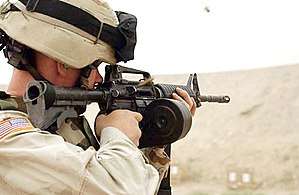High-capacity magazine
A high-capacity magazine (or large-capacity magazine) is a firearm magazine capable of holding more than the standard number of rounds provided by the designer, or legally, a particular number of cartridges dependent on jurisdiction and kind of firearm.[1]

Types, characteristics, and manufacturers
Drum magazines are high-capacity magazines that are in a cylindrical shape; they once had a reputation for unreliability, but technological improvements resulted in better performance and cheaper cost.[2] As a result, drum magazines became more common in the civilian market in the United States, although they are far less common than standard, lower-capacity box magazines.[2] As of 2019, about six manufacturers produced drum magazine in the United States, retailing for about $100 each.[2] Manufacturers include KCI USA and Magpul Industries; the latter produces the same drum magazines for both civilian and military use.[2]
Legal status
United States
Federal law
Between 1994 and 2004, the Federal Assault Weapons Ban, which included a ban on high-capacity magazines, was in effect. It prohibited new magazines over 10 rounds in the United States.[2] After the expiration of the ban, there is no nationwide prohibition against the possession of high-capacity magazines, which are considered an unregulated firearm accessory.[2]
Legislation to restore a federal high-capacity magazine ban has been repeatedly introduced by Democrats in the United States Congress since the expiration of the Federal Assault Weapons Ban, especially in the wake of mass shootings in the United States in which high-capacity magazines were used, including the Tucson shooting (2011), the Aurora, Colorado movie theater shooting (2012), and the Harvest music festival shooting (2017).[3][4] These efforts have been thus far unsuccessful. The federal Keep Americans Safe Act, which would restore the ban on new magazines that hold more than 10 rounds, passed the House Judiciary Committee in September 2019.[5][6]
State laws
As of 2019, nine states and the District of Columbia set a maximum limit on the capacity of magazines for at least some firearms.[7][8] The nine states with high-capacity-magazine limitations are California (Proposition 63, passed in 2016), Colorado, Connecticut, Hawaii, Maryland, Massachusetts, New Jersey, New York, and Vermont.[8] Hawaii's magazine-size limitation only applies to handguns; the laws in the other eight states and D.C. apply to all types of guns.[8] All of the ten jurisdictions with magazine-size limits set the maximum at 10 rounds, except for Colorado (which sets a maximum of 15 rounds) and Vermont (which sets a maximum of 15 rounds for handguns and 10 rounds for long-guns).[8] The types of acts prohibited varies among the ten jurisdictions; most prohibit manufacturer, sale, or possession, but some states' laws are narrower (Maryland law does not ban possession of high-capacity magazines) while other states' laws are broader (some states also ban the transfer, transportation, or acquisition of high-capacity magazines).[8] Some states' laws include "grandfather" pre-ban high-capacity magazines, exempting these from their law, while other states' laws do not.[8]
The constitutionality of high-capacity magazine bans has been repeatedly upheld by the courts, including the U.S. Courts of Appeals for the Seventh Circuit,[9][10] Third Circuit,[11] and Fourth Circuit.[12] In March 2019, U.S. District Judge Roger T. Benitez ruled that California's high-capacity magazine ban violated the Second Amendment to the United States Constitution,[13] but stayed the order pending appeal, acknowledging the court decisions elsewhere that have affirmed the constitutionality of such bans.[14] The case is now pending before the U.S. Court of Appeals for the Ninth Circuit.[15]
Australia
In Australia, handgun magazines holding more than ten rounds as well as rifle magazines holding more than 15 rounds are heavily restricted.[16]
See also
| Wikiquote has quotations related to: High-capacity magazine |
References
- Rose, Veronica (January 24, 2013). "Laws on High Capacity Magazines". cga.ct.gov. Connecticut General Assembly. Retrieved April 9, 2014.
- Ben Kesling & Zusha Elinson, Mass Shootings Draw Attention to 'Drum Magazines', Wall Street Journal (August 16, 2019).
- Jennifer Steinhauer, Pro-Gun Lawmakers Are Open to Limits on Size of Magazines, New York Times (February 18, 2013).
- Elizabeth Landers, Democrats propose high-capacity gun magazine ban, CNN (February 12, 2019).
- H.R.1186 - Keep Americans Safe Act, 116th Congress (2019-2020), Congress.gov.
- Clare Foran, House Judiciary Committee votes to approve red flag bill and high capacity magazine ban, CNN (September 11, 2019).
- Griff Witte, As mass shootings rise, experts say high-capacity magazines should be the focus, Washington Post (August 18, 2019).
- Large Capacity Magazines, Giffords Law Center to Prevent Gun Violence.
- Asher Stockler, Federal Appeals Court Upholds Ban on Assault Weapons, Large-Capacity Magazines, Newsweek (August 29, 2019).
- Bobby Allyn, U.S. Appeals Court In Chicago Again Upholds Laws Banning Assault Weapons, NPR (August 29, 2019).
- Federal court upholds New Jersey gun-control law limiting high-capacity magazines, Associated Press (December 5, 2018.
- Lyle Denniston, Supreme Court Justices allow ban on high-capacity guns, National Constitution Center (November 27, 2017).
- Thompson, Don. "Federal judge blocks high-capacity ammunition ban in California". usatoday.com. Retrieved 2019-03-30.
- Judge who blocked California's ban on high-capacity magazines halts their sales for now, Associated Press (April 5, 2019).
- Attorney General Becerra Continues Fight in Duncan v. Becerra, Defending California's Law that Bans the Acquisition and Possession of Large-Capacity Magazines (press release), Office of the California Attorney General (July 16, 2019).
- "Prohibited Goods - Firearms". Retrieved 2019-09-13.
Further reading
- Jonsson, Patrik (January 16, 2013). "Gun debate 101: Time to ban high-capacity magazines?". Christian Science Monitor. Christian Science Monitor. Retrieved May 14, 2014.
- Richman, Josh (March 12, 2014). "Sunnyvale gun law: Supreme Court justice refuses to stay ban on large-capacity magazines". San Jose Mercury News. San Jose, California. Retrieved May 14, 2014.
- Shermer, Michael (2013). "The Sandy Hook Effect". Skeptic. Retrieved April 24, 2014.